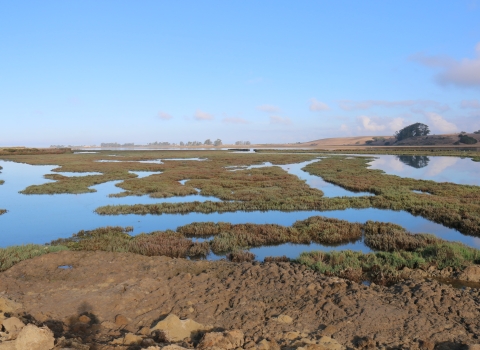The U.S. Fish and Wildlife Service (Service) completed status reviews for 17 species that were candidates for listing under the Endangered Species Act (ESA) and found that all are now doing well and no longer warrant listing. These species will be removed from the ESA Candidate List. These findings represent years of collaborative efforts across the United States to conserve and restore once-imperiled species and their habitats and eliminate the need for ESA protection.
The 17 species that will be removed from the Candidate List are the Cumberland arrow darter, Great Basin population of the Columbia spotted frog, Goose Creek milkvetch, Nevares Spring naucorid bug, Page springsnail, Ramshaw meadows sand verbena, Sequatchie caddisfly, Siskiyou mariposa lily, Sleeping ute milkvetch, Southern Idaho ground squirrel, Tahoe yellow cress and six Tennessee cave beetles (Baker Station, Coleman, Fowler's, Indian Grave Point, Inquirer, and Noblett's beetles).
Additionally, the Service has determined that petitions to list the American eel and Shawnee darter are not warranted under the ESA. Neither are on the ESA candidate species list.
The not warranted determinations (known as 12-month findings) represent compelling examples of American conservation and demonstrate that how the ESA inspires collaboration between federal and state agencies, private companies, conservation organizations and individual landowners.
“We are proud of our close work with so many diverse stakeholders, and of the role of the Endangered Species Act in supporting these collaborations,” said Service Director Dan Ashe. “This model of proactive conservation and partnership should give critics of the Act pause and make us all consider what would be lost to future generations of Americans by weakening the nation’s foremost wildlife conservation law.”
Some examples of the success stories in this status review include:
States and landowners address threats to Great Basin population of Columbia spotted frog. Located in Nevada, southwestern Idaho and southeastern Oregon, the Columbia spotted frog lives its entire life in water and faced the threat of declining water quantity and quality. Following the designation of the frog as an ESA candidate species, states, federal agencies and private landowners went to work clarifying solutions, employing sustainable grazing practices, and creating ponds where the frog has taken up residence and is successfully breeding. As a result of these collaborative conservation efforts, population numbers of the Great Basin Columbia spotted frog have rebounded.
Stakeholders return Siskiyou mariposa lily to healthy populations in northern California. When it was listed as a candidate for the ESA, the Siskiyou mariposa lily was threatened with extinction by loss of habitat from disturbance and non-native invasive plants. In response, the Service partnered with the state of California, private landowners, Siskiyou County Department of Agriculture, Klamath National Forest and Bureau of Land Management (BLM) to remove invasive plants from lily habitat on federal and private lands and limit harmful soil disturbance activities.
BLM and Service agreements protect and restore imperiled Goose Creek milkvetch. The milkvetch is located primarily on federal lands in Idaho, Nevada and Utah, and following its listing as an ESA candidate species the Service partnered with BLM and state natural heritage programs to restore and protect its habitat from the invasive plant, leafy spurge. Through a voluntary arrangement called a Candidate Conservation Agreement, federal agencies have protected 86% of the milkvetch’s population and 93% of its known habitat.
State of Arizona and Service collaborate on Page springsnail. The Service worked with Arizona Game and Fish Department on a voluntary conservation agreement that restored Page springsnail habitat on state lands. Through this effort, Arizona enhanced natural springs, created artificial springbrooks, added substrate preferred by the snail, and salvaged snails during the eradication of non-native species. Eight of the ten Page springsnail populations are now stable or increasing.
Kentucky, U.S. Forest Service and Service work together on Cumberland arrow darter. In addition to benefiting from laws and regulations protecting listed fish in its habitat, the Cumberland arrow darter is also aided by the Forest Service's management efforts on Daniel Boone National Forest. Other efforts include range-wide distributional surveys and habitat analyses by the Kentucky Department of Fish and Wildlife Resources, Kentucky State Nature Preserves Commission, Tennessee Wildlife Resources Agency and the Service, which have found 38 additional streams inhabited by the darter.
Diverse stakeholders restore the New England cottontail. Earlier this month, Secretary of the Interior Sally Jewell, Service Director Dan Ashe, New Hampshire Senator Jeanne Shaheen and leaders of state wildlife agencies announced that the New England cottontail would be removed from the ESA Candidate List, due to successful efforts of states, private landowners, federal agencies and non-profit organizations. The improved young forest habitat that resulted from these efforts benefits not only the cottontail, but at least 65 other species, including woodcock, bobcats, snowshoe hares, songbirds, box turtles and frosted elfin butterflies.
A summary of all findings in this batch along with their docket numbers can be found at www.federalregister.gov/public-inspection by clicking on the 2015 Notices link under Endangered and Threatened Wildlife and Plants. It is also available at www.fws.gov/policy/frsystem/default.cfm. Information can be submitted on species for which a status review is being initiated, using the specified docket number, beginning upon publication in the Federal Register, for 60 days until December 7, 2015.

